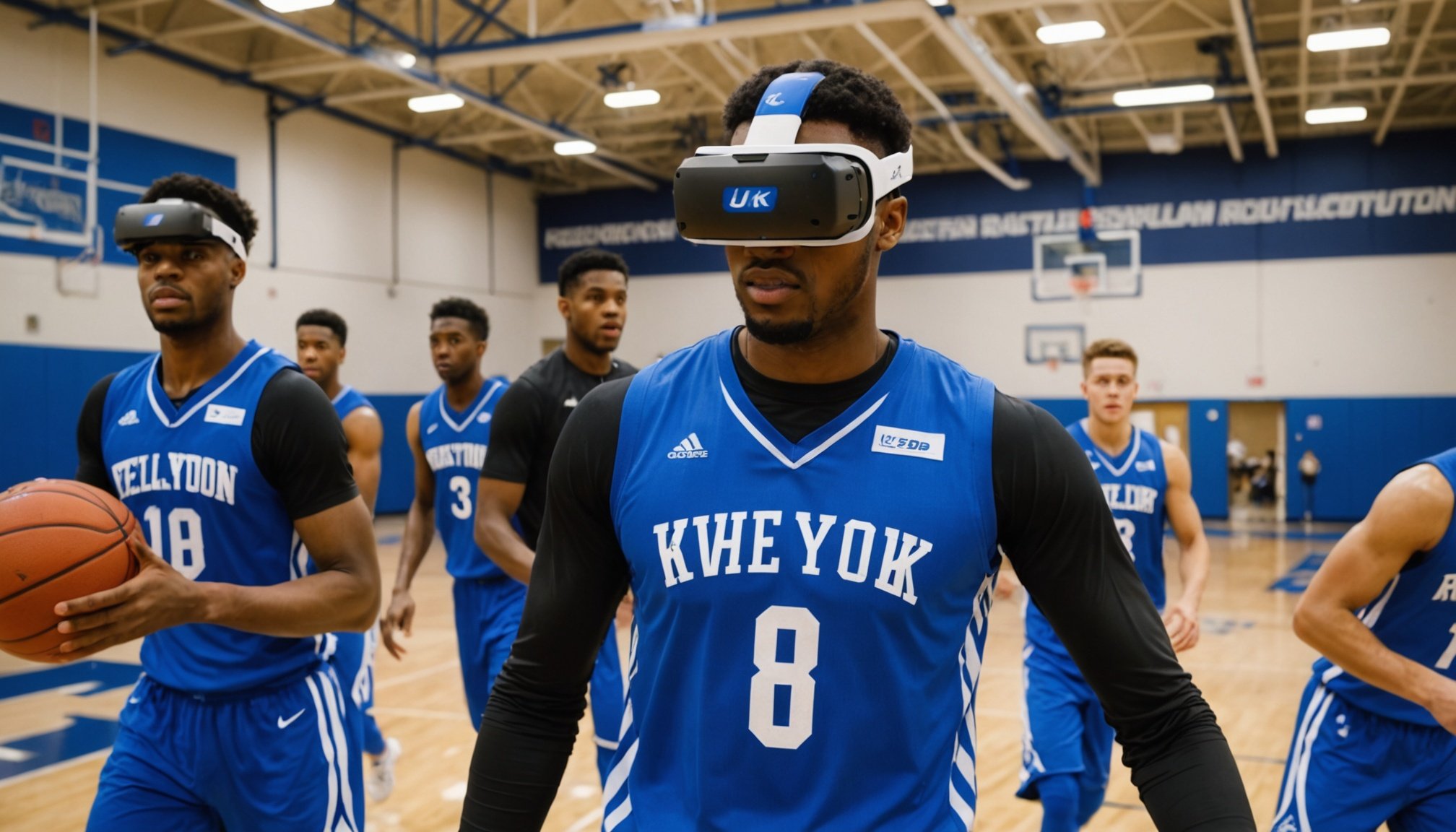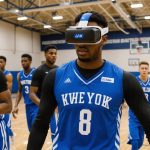Introduction to Virtual Reality in Basketball Training
In recent years, virtual reality (VR) has significantly influenced the landscape of basketball training, heralding a new era of innovation. Virtual reality involves simulating real-world environments through technology, which users can interact with in a highly immersive manner. This groundbreaking approach provides athletes with a unique platform to refine their skills and strategies without being physically present on the court.
Innovative training methods are crucial in basketball as they offer fresh perspectives and enhance the skill set of players. Advanced technologies like virtual reality facilitate a controlled environment where basketball players can experience scenarios that closely mirror real-game situations. This type of training allows for focused skill development and strategic planning, free from the physical and logistical constraints of traditional practice sessions.
Also to discover : Top Plyometric Workouts to Boost Speed for Basketball Players in the UK
The incorporation of VR in sports technology is currently on an upward trend, promising to boost performance enhancement significantly. Virtual reality enables players to analyse complex tactics and refine their decision-making processes in real time. As a result, these trends highlight a heightened emphasis on developing adaptable training routines that foster better athletic performance. Consequently, integrating VR into basketball training is increasingly considered indispensable for athletes striving for success.
Advantages of Virtual Reality for Basketball Teams
Virtual Reality (VR) offers numerous benefits to basketball teams, revolutionising skill development and enhancing overall performance. One major advantage is its impact on player visualisation and decision-making. Through VR simulations, players can immerse themselves in realistic game scenarios, allowing them to practice and refine their strategies without physical constraints. This experience enhances their understanding of the game, leading to more informed decisions during actual matches.
Have you seen this : Top Cross-Training Strategies for UK Basketball Players to Combat Burnout and Boost Performance
Additionally, VR significantly improves reaction times and situational awareness. Athletes can repeatedly face various play situations, learning to anticipate opponents’ moves and adjust strategies swiftly. This targeted practice develops faster reflexes and a sharper perception of the playing environment, giving players a competitive edge.
Another notable benefit is the reduction of injury risk. VR environments enable players to engage in controlled training sessions where intensity and conditions can be monitored. This approach minimises the physical strain associated with traditional training and allows injured players to continue refining their skills without aggravating their condition.
In summary, the incorporation of VR in basketball training provides a comprehensive tool that fosters skill growth, enhances performance, and mitigates injury risks, ultimately transforming how teams prepare and compete.
Case Studies of UK Basketball Teams Using VR
Exploring the transformative impact of VR in basketball, numerous UK teams have begun integrating this technology into their training regimes, with remarkable results.
Successful Implementation at [Team Name]
One notable case is [Team Name], which successfully adopted VR techniques. This team utilized VR simulations to create virtual game environments that enhanced players’ spatial awareness and strategic thinking. By simulating real-game situations, players had the opportunity to rehearse plays and sharpen their skills in a risk-free setting.
Results and Performance Metrics
Teams employing VR have seen measurable improvements. Performance metrics demonstrate a significant growth in shooting accuracy and decision-making speed. For instance, teams have reported a boost of up to 20% in player efficiency ratings. This technological leap indicates that VR training can replicate real-world dynamics, offering players substantial practice advantages without physical strain.
Feedback from Coaches and Players
Players and coaches alike applaud VR for its immersive experience and practical applications. Coaches note that VR enhances player engagement during practice sessions, while players appreciate the reduced injury risk. Many athletes cite increased confidence from experiencing pressure situations in a controlled environment. These insights underscore the potential of VR as a game-changer in sports training.
Overview of Popular VR Tools and Software for Basketball
Exploring VR tools and basketball software can significantly enhance basketball training. These technologies offer innovative solutions for player development and tactical analysis.
Leading VR Applications for Basketball Training
Among the most prominent VR tools in this field is STRIVR, known for its capability to simulate real-game scenarios, allowing players to improve decision-making without physical strain. Similarly, Rezzil offers advanced cognitive development exercises, crucial for sharpening mental toughness and concentration.
Comparative Analysis of Features and Usability
When evaluating these tools, consider their usability. STRIVR provides a user-friendly interface, making it accessible even to beginners. On the other hand, Rezzil’s complex metrics might require more technical understanding but offer in-depth performance analysis.
Recommendations for Teams Considering VR Integration
For teams looking to integrate training technology, starting with VR applications that offer customizable training scenarios can be beneficial. Prioritize tools that align with your team’s specific goals. Consider the ease of integration into existing training regimes to ensure seamless implementation.
In summary, VR tools tailored to basketball offer diverse features that can transform training routines, providing an edge in both skill enhancement and tactical preparation.
Expert Opinions on VR Training in Basketball
Virtual reality (VR) is transforming how basketball coaches and analysts approach training. Expert Insights reveal its potential for sharpening skills without physical strain. Interviews with coaches highlight innovative Coaching Strategies. VR immerses players in game scenarios, allowing them to practice decision-making. This contributes to improved spatial awareness.
Interviews with Coaches and Analysts
Coaches emphasise the value of VR for visualisation techniques. An analyst noted, “VR Technology offers a fresh way to instil competitive strategies.” Coaches believe VR enhances player learning by providing real-time feedback which traditional methods lack.
Perspectives on Future Trends in Training
Experts predict VR will become a staple in basketball training. The potential for personalisation, where athletes can tailor sessions to specific skills, is seen as a major benefit. As VR advances, coaches anticipate even more sophisticated training tools.
Barriers to Adoption and Solutions
Despite the potential benefits, cost and technological complexities are significant barriers. To overcome these, experts suggest partnerships with tech firms to subsidise costs. Developing user-friendly interfaces could also ease integration for non-tech savvy coaches, making VR more accessible.
Conclusion on Leveraging VR Technology
The Future of Training lies in the hands of technology, with Virtual Reality (VR) at the forefront. Significant case studies have demonstrated transformative results across numerous sectors. For instance, companies adopting VR have seen improved employee performance and higher engagement levels. The adaptability of VR enables coaching innovation, allowing trainers to simulate real-life situations that enhance learning experiences and skills retention.
Moreover, VR adoption offers organisations a competitive edge. In today’s fast-paced market, staying ahead with technological advancements is crucial. VR not only provides immersive learning but also fosters an interactive environment that can be tailored to meet unique organisational needs. This capability allows teams to train under various scenarios, ensuring comprehensive readiness and preparation.
It’s essential for businesses to realise the importance of incorporating VR technology in their training modules. By doing so, they can harness the full potential of coaching innovation, and transform mundane routines into engaging experiences. Teams should be encouraged to explore VR opportunities, as this technology stands as a testament to the future of training. Taking initiative in this endeavour could significantly enhance team capabilities, propelling organisations forward.
Overview of Virtual Reality in Sports Training
Virtual Reality (VR) is revolutionising the world of sports training. Initially devised as an immersive experience primarily for gaming, VR has found its way into the realm of sports, offering a unique dimension to training methodologies. By simulating real-world environments, athletes can hone their skills in a controlled setting, reducing the risk of injury and allowing repetitive practice without physical strain.
The current landscape for technology in training environments is witnessing an increasing integration of VR. In sports like basketball, VR is enhancing athlete performance analysis by replicating exact game scenarios. Players can analyse their moves and receive instantaneous feedback, which promotes tactical awareness and decision-making skills.
Key trends indicate a growing reliance on VR, with sports franchises recognising its potential to enhance competitiveness. The technology is gradually becoming a staple for teams aiming to gain a strategic advantage. As VR evolves, its application widens, breaking traditional barriers and setting the stage for more data-driven, precise training regimens. Through these innovations, VR not only augments the physical aspect of training but also sharpens the mental acuity of athletes.
Applications of Virtual Reality in Basketball Training
Virtual Reality (VR) technology has revolutionised basketball training, creating new ways to develop skills. It offers advanced VR applications that enhance traditional methods and provide athletes with cutting-edge tools for improvement.
Enhanced Drills Through VR
Through VR, players can participate in enhanced drills designed specifically for basketball. These exercises replicate real responses and movements, allowing athletes to practice techniques like shooting, dribbling, and defending in a virtual setting. With the variability and realism VR introduces, players can refine their movements in a controlled, safe environment without the risk of injury.
Game Simulation and Strategy
Virtual reality simulation replicates real-game scenarios, enabling strategic development. Players are thrust into hyper-realistic environments where they must make split-second decisions and face unpredictable challenges. This not only prepares them for actual match conditions but also helps them develop tactical awareness and problem-solving skills during intense moments.
Skills Assessment and Feedback
The use of VR provides invaluable performance feedback. With sophisticated data analytics, the VR technology evaluates a player’s skills, highlighting strengths and weaknesses. This feedback loop is instrumental in refining techniques, ensuring targeted skill development. Tailored feedback allows athletes to focus on specific areas needing improvement, enhancing overall performance.
Case Studies of UK Basketball Teams Using VR
In recent years, several UK basketball teams have embraced the potential of VR technologies to enhance training and performance. These case studies illuminate the promising integration of VR in basketball, showcasing its impact on training regimens, strategic preparation, and player development.
One noted team implementing VR technologies is the London Lions. They have utilised VR to conduct realistic game simulations, enabling players to experience different strategic scenarios without physical exertion. This approach has enhanced their decision-making and visualisation skills, ultimately contributing to improved game performance.
VR implementation has also been adopted by the Glasgow Rocks. Utilising virtual environments, they focus on refining complex play strategies and individual skills. VR offers their athletes the opportunity for repeated practice of critical scenarios, which boosts player confidence and cognitive responses on the court.
Coaches from these teams have noted significant advancements. One coach remarked, “VR technologies have revolutionised our training. Players respond better and are more mentally prepared.” The feedback underscores the role of VR in understanding game dynamics and improving overall team synergy.
These case studies highlight how VR can serve as an innovative training tool, fostering a new era of growth in UK basketball.
Benefits of Virtual Reality Training
Implementing virtual reality (VR) in training offers numerous advantages that enhance player development. One of the most significant benefits is the improvement in cognitive skills and decision-making. With immersive VR scenarios, players experience real-time situations that can fast-track their ability to think and react swiftly. This nurtures their strategic thinking, allowing them to anticipate and respond to on-field challenges effectively.
Moreover, VR technology contributes to performance enhancement by increasing engagement and motivation among players. As they immerse themselves in realistic environments, the training becomes more captivating, holding their attention and encouraging consistent practice—key elements for skill improvement.
Another noteworthy benefit is the focus on safety and risk reduction during training sessions. Thanks to VR, athletes can simulate high-risk scenarios without the physical dangers associated, minimizing the possibility of injury. This safe space for trial and error builds confidence, ultimately preparing players more thoroughly for real-world challenges.
These numerous advantages of VR training underscore its value in contemporary player development, providing a cutting-edge tool for honing skills in a controlled yet dynamic environment. The integration of VR technology is indeed revolutionizing how athletes prepare and perform.
Challenges of Implementing VR in Training
Implementing virtual reality (VR) in basketball training presents several challenges, particularly concerning VR integration into established routines.
Technical Limitations and Costs
The technological requirements for VR integration can be prohibitive. High-quality VR systems require significant financial investment, not only in initial purchase but also in ongoing maintenance and upgrades. Training facilities must calibrate hardware to ensure seamless functionality, often necessitating specialised technical support. The cost can be a barrier for many programs, especially those operating on tight budgets.
Player Adaptation and Acceptance
Adapting to and accepting VR as part of basketball training can be daunting for some players. The learning curve is evident; players unfamiliar with VR might initially experience discomfort or scepticism. Encouraging an open mindset and offering educational resources can ease this transition. Demonstrating the benefits and practicality of VR, such as enhanced game strategy comprehension, may boost acceptance levels among players.
Balancing VR with Traditional Training Methods
Integrating VR without disrupting traditional techniques involves careful planning. Establishing a strategy that respects the merits of both VR and traditional methods is crucial for holistic player development. Coaches can begin by using VR as a supplementary tool, blending it gradually to complement physical drills and enhance overall training efficiency. This balance aids in maximising the effectiveness of both methodologies.
Tips for Effective Implementation of VR in Basketball Training
When considering implementation strategies for VR in basketball, it’s crucial for teams and coaches to select the right VR technology. Begin by assessing the specific needs of the team—whether it’s for improving reaction times or understanding strategic plays better. Researching various VR options and consulting with VR coaches can lead to informed decisions.
Once the technology is selected, the next step involves integrating VR into existing training schedules. Effective training requires a balance; VR sessions should complement physical training without causing fatigue. Coaches can schedule VR sessions on rest days or after lighter practice sessions, ensuring players remain engaged and avoid burnout.
Continuous evaluation and adaptation are key to the success of VR training programs. Regular feedback from players, combined with performance metrics, helps refine VR sessions to meet evolving team needs. Adjusting the intensity, focus, and duration of VR activities ensures the technology remains effective and relevant.
VR coaches play an important role in this process, providing expertise and helping tailor the experience to the team’s goals. With these steps, basketball teams can harness the full potential of VR, leading to enhanced on-court performance.










